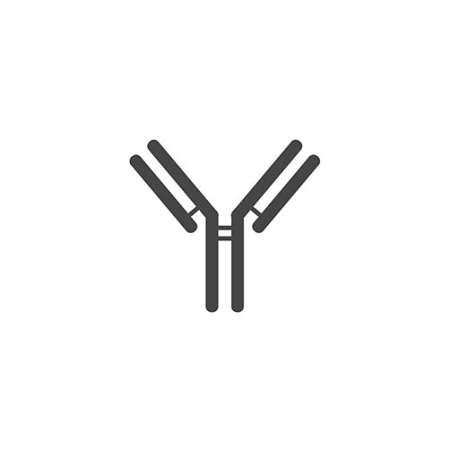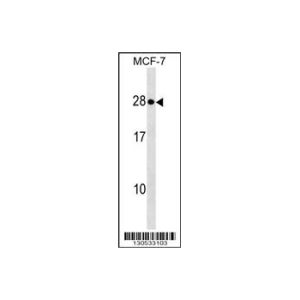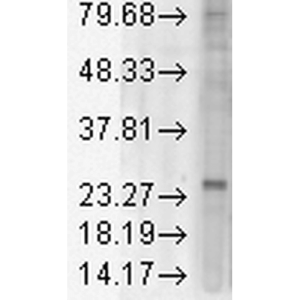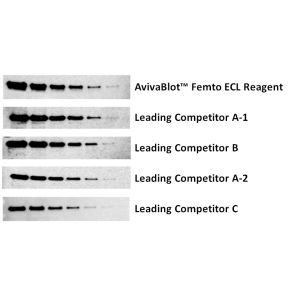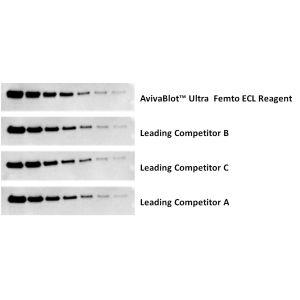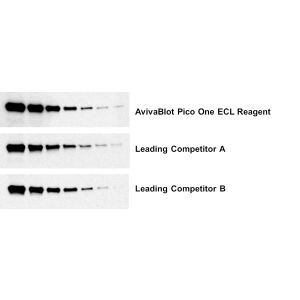KDELR1 Antibody
Katalog-Nummer OASE00114
Size : 100ug
Marke : Aviva Systems Biology
| Datasheets/Manuals | Printable datasheet for HDEL Antibody (OASE00114) |
|---|---|
| COA Datasheet | 1 µg/ml of SMC-175 was sufficient for detection of HDEL-containing proteins in 10 µg of S. cerevisiae lysate by colorimetric immunoblot analysis using Goat anti-mouse IgG:HRP as the secondary antibody. |
| Predicted Species Reactivity | Barnyard Grass|Beet|Cotton|Drosophila|Drosophila melanogaster|Mung Bean|Plant|Saccharomyces cerevisiae|Sorghum|Wheat|Yeast |
|---|---|
| Clonality | Monoclonal |
| Clone | 2E7 |
| Isotype | IgG2b |
| Host | Mouse |
| Conjugation | Unconjugated |
| Application | ICC,IF,WB |
| Additional Information | Background Info: Detects ~78kDa. |
| :: | Scientific Background: HSP 70 family comprises four highly conserved proteins, HSP 70, HSC 70, GRP 75 and GRP 78, which serve a variety of roles. They act as molecular chaperones, facilitating the assembly of multi-protein complexes; participate in the translocation of polypeptides across cell membranes and to the nucleus; and aid in the proper folding of nascent polypeptide chains (1, 2). GRP 78 is localized in the endoplasmic reticulum (ER), where it receives imported secretory proteins and is involved in the folding and translocation of nascent peptide chains (2). Sorting of these proteins is dependent on a C-terminal tetrapeptide signal, usually KDEL in animal cells, and HDEL in S.cerevisiae (3). The 2E7 clone recognizes the C-terminal peptide HDEL, a common version of the endoplasmic reticulum retention signal found in yeast, plant, nematode and other ER proteins. 2E7 specifically stains HDEL proteins in barnyard grass, beet, cotton, mung bean, sorghum and wheat (4). |
| :: | Certificate of Analysis: 1 ug/mL was sufficient for detection of HDEL-containing proteins in 10ug of S. cerevisiae lysate by colorimetric immunoblot analysis using Goat anti-mouse IgG:HRP as the secondary antibody. |
| Reconstitution and Storage | -20°C |
| Immunogen | Raised against a synthetic HDEL peptide corresponding to the C-terminus of yeast Bip |
| Purification | Protein G Purified |
| Concentration | 1 mg/ml |
| Specificity | Detects ~78kDa. |
| Dilution | WB (1:1000), ICC/IF (1:100); optimal dilutions for assays should be determined by the user. |
| Storage Buffer | PBS pH7.4, 50% glycerol, 0.09% sodium azide |
| Description | HSP 70 family comprises four highly conserved proteins, HSP 70, HSC 70, GRP 75 and GRP 78, which serve a variety of roles. They act as molecular chaperones, facilitating the assembly of multi-protein complexes; participate in the translocation of polypeptides across cell membranes and to the nucleus; and aid in the proper folding of nascent polypeptide chains (1, 2). GRP 78 is localized in the endoplasmic reticulum (ER), where it receives imported secretory proteins and is involved in the folding and translocation of nascent peptide chains (2). Sorting of these proteins is dependent on a C-terminal tetrapeptide signal, usually KDEL in animal cells, and HDEL in S.cerevisiae (3). The 2E7 clone recognizes the C-terminal peptide HDEL, a common version of the endoplasmic reticulum retention signal found in yeast, plant, nematode and other ER proteins. 2E7 specifically stains HDEL proteins in barnyard grass, beet, cotton, mung bean, sorghum and wheat (4). |
| Reference | 1. Mayer M.P., and Bukau B. (2005) Cell Mol Life Sci. 62(6): 670-684. 2. Luo S., Mao C., Lee B., and Lee A.S. (2006) Mol Cell Biol. 26(15): 5688-5697. 3. Entrez Gene: HDEL, Gene ID: 10945 4. Napier R.M., et al. (1992) J Cell Sci. 102: 261-271. |
|---|---|
| Gene Symbol | HDEL |
| Gene Full Name | ER lumen protein-retaining receptor 1 |
| Alias Symbols | H-D-E-L (his-asp-glu-leu), endoplasmic reticulum, luminal ER protein retention, KDELR1, Endoplasmic reticulum retention signal |
| Protein Name | ER lumen protein-retaining receptor 1 |




